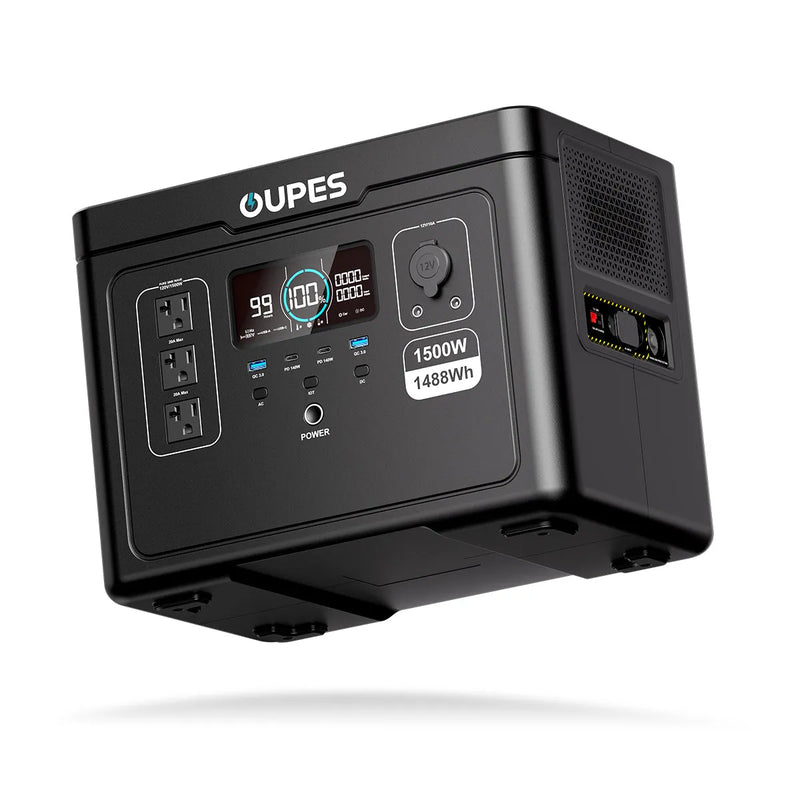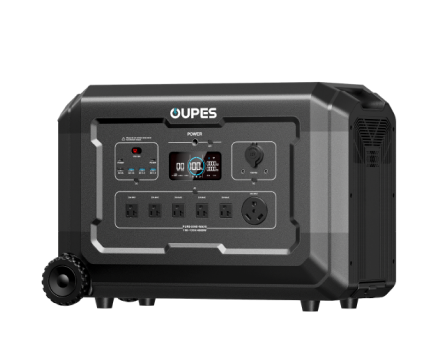
As temperatures rise, staying cool with a portable air conditioner becomes essential. However, many people struggle to determine how much power is required to run these units effectively. Understanding the wattage needed is crucial for selecting the right portable power station or generator, especially during power outages or in off-grid environments.
This article explores everything you need to know about powering a portable AC, from energy requirements and power station compatibility to efficiency tips and environmental factors. By the end, you??ll have the knowledge to make informed decisions about keeping your space comfortable while using portable energy solutions like OUPES.
Understanding Portable Air Conditioner Power Consumption
Portable air conditioners vary widely in power consumption, typically ranging between 800 and 2,200 watts depending on size, cooling capacity, and efficiency. Smaller units designed for personal spaces may consume less, while larger models intended for entire rooms require significantly more energy.
The wattage listed on the air conditioner is often the running wattage, but startup wattage can be higher due to the compressor. Many portable AC units experience a surge in power when the compressor starts, which can be two to three times the running wattage. This is critical when pairing an AC with a portable power station; the station must be capable of supplying both the surge and continuous power.
Environmental conditions also affect energy consumption. Hotter rooms or direct sunlight exposure will force the unit to work harder, drawing more watts to maintain the desired temperature. Proper placement and insulation of the room can significantly reduce power demand, allowing a portable power station to maintain operation longer.
Understanding the AC??s power requirements and how environmental factors influence energy use allows users to select an appropriate power solution that can reliably run their portable air conditioner when needed.
Calculating the Watts Needed for Your Portable AC
Calculating the watts required to run a portable air conditioner begins with knowing the unit??s specifications, usually listed in watts or BTU (British Thermal Units). Typically, 1,000 BTU equals about 0.293 watts, providing a conversion for units that list cooling capacity instead of power consumption.
To estimate energy requirements, consider both running and startup wattage. For example, a 1,500-watt AC unit with a startup surge of 3,000 watts requires a power station capable of handling the surge for a few seconds while providing consistent 1,500 watts for continuous operation. Ignoring the surge can result in the unit failing to start or tripping the power source??s protection mechanisms.
Other factors to include are the room size, insulation, and outside temperature. A larger or poorly insulated room will require the AC to work harder, increasing energy draw. Adding a safety margin of 20-30% to the calculated wattage ensures the portable power station can operate the AC without stress.
By accurately calculating wattage requirements, users can select a power station that provides sufficient energy for uninterrupted cooling, ensuring comfort and reliability during high-temperature periods or emergencies.
Choosing a Portable Power Station for Your AC
Once you understand the wattage needed, selecting a compatible portable power station is essential. Capacity, measured in watt-hours (Wh), determines how long the AC can run. For example, a 2,000Wh unit can theoretically power a 1,500-watt AC for around 1.3 hours under ideal conditions. Efficiency losses, typically around 10-15%, should be accounted for in these calculations.
Output capabilities are equally important. The power station must supply enough surge power to start the AC??s compressor. High-quality units like OUPES provide surge capacity and continuous output to accommodate both startup spikes and ongoing energy needs. Choosing a station with solar charging or expansion options extends runtime, particularly during prolonged power outages.
Additional considerations include portability, battery type, and safety features. Lithium-ion batteries are lighter and more durable than lead-acid alternatives, while integrated protections prevent overload or short circuits. A power station with multiple AC outlets and USB ports allows simultaneous operation of other essential devices, enhancing household resilience during outages.
Selecting the right portable power station ensures reliable, efficient operation of a portable air conditioner, allowing homeowners to maintain comfort without risking power shortages or device damage.
Tips to Optimize AC Runtime on a Power Station
Maximizing the runtime of a portable air conditioner on a power station requires careful planning and energy management. Keep the room insulated and limit heat sources to reduce the AC??s workload. Closing curtains, using fans, and sealing drafts can significantly lower power consumption.
Adjusting the AC??s temperature settings slightly higher during operation reduces energy draw while still maintaining comfort. Avoid frequently turning the unit on and off, as repeated startup cycles increase power demand. Using ice packs or small portable coolers for beverages can reduce the AC??s operating time by decreasing frequent door openings or additional heat sources.
Monitor the power station??s battery level and recharge proactively, especially if relying on solar panels or external charging. Disconnect non-essential devices to allocate maximum power to the AC. Efficient usage strategies ensure longer runtime and prevent unexpected shutdowns during peak heat periods.
By implementing these tips, you can extend the duration a portable air conditioner runs on a portable power station, ensuring consistent cooling when it??s most needed.
Factors Affecting AC Power Consumption and Runtime
Several factors influence the wattage a portable air conditioner requires and the duration it can run on a power station. Ambient temperature, humidity, and room size play major roles. Hot, humid environments increase the AC??s workload, consuming more watts and reducing runtime.
AC unit efficiency, age, and maintenance status also affect energy usage. Older units or those with clogged filters or dirty coils require more power to achieve the same cooling effect. Regular maintenance, such as cleaning filters and ensuring proper ventilation, improves efficiency and prolongs runtime on a portable power station.
Environmental placement matters; keeping the AC out of direct sunlight, near heat sources, or in enclosed spaces can increase energy consumption. Additionally, battery efficiency, inverter quality, and energy losses during conversion affect overall runtime. Understanding and optimizing these factors allows users to achieve longer, more reliable AC operation during power outages or off-grid scenarios.
Careful planning and awareness of these influences ensure homeowners can effectively power a portable AC with a portable power station, maintaining comfort while managing energy resources efficiently.
In summary, determining the watts required to run a portable air conditioner involves understanding the unit??s power needs, accounting for surge and running wattage, and considering environmental factors. Choosing a reliable portable power station like OUPES, managing usage efficiently, and maintaining the AC unit ensures reliable cooling during power interruptions or off-grid applications.
By combining accurate calculations, proper power station selection, and energy-saving strategies, you can enjoy consistent comfort even during high temperatures or emergencies. Portable AC units paired with suitable power stations provide flexible, dependable solutions for modern households facing power challenges.




























